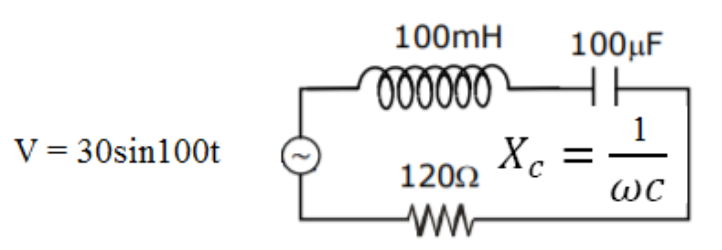
Question: Find the peak current and resonant frequency of the following circuit (as shown in figure).

a. $0.2$A and $100$ Hz.
b. $2$A and $50$ Hz.
c. $2$A and $100$ Hz.
d. $0.2$A and $50$ Hz.
Answer
218.4k+ views
Hint: We have the knowledge or we know the formula regarding the voltage in a LCR circuit. With the help of this formula we will derive out the variables first. Then, we will use the relation between impedance and peak current to find the current in the circuit. Lastly, we will use the relation between frequency to inductance and capacitance to find the resonant frequency of the LCR circuit.
Complete answer:
First of all, the relation between sinusoidal voltage, amplitude, frequency and time is represented as:
$V={{V}_{0}}\sin \omega t$---(i)
Where $V=$ final or sinusoidal voltage
${{V}_{0}}=$ amplitude of the voltage
$\omega =$ frequency of the wave
$t=$ time
The question has already provided us with the relation of sinusoidal voltage as,
$V=30\sin 100t$---(ii)
Therefore, comparing equation (i) and equation (ii) we get,
${{V}_{0}}=30$--(iii) and $\omega =100$---(iv)
Now, the relation between peak current and impedance is given as,
$i=\dfrac{{{V}_{0}}}{Z}$---(v)
Where $i=$ peak current and $Z=$ impedance.
The formula for impedance is,
$Z=\sqrt{{{\left( {{X}_{L}}-{{X}_{C}} \right)}^{2}}+{{R}^{2}}}$---(vi)
The variables are defined as,
${{X}_{L}}$ is the resistance due to inductor, ${{X}_{C}}$ is the resistance due to capacitor and $R$ is the resistance of the circuit.
Again, ${{X}_{L}}=\omega L$---(vii)
$L=$ inductance of the circuit.
Substituting the values given in the question we get,
${{X}_{L}}=100\times (100\times {{10}^{-3}})=10$--(viii)
Now, ${{X}_{C}}=\dfrac{1}{\omega \times C}$--(ix)
Where $C=$ capacitance of the circuit
Substituting the values from the given question we get,
${{X}_{C}}=\dfrac{1}{100\times 100\times {{10}^{-6}}}=100$---(x)
Substituting these values from equation (viii) and (x) to equation (vi) we get,
$Z=\sqrt{{{\left( 10-100 \right)}^{2}}+{{120}^{2}}}=150$---(xi)
Substituting the value from equation (xi) to equation (v) we get,
$i=\dfrac{30}{150}=0.2$
So, the peak current is $0.2$ A.
We know for resonant frequency,
$\omega =\dfrac{1}{\sqrt{LC}}$--(xii)
Substituting the values we get,
$\omega =\dfrac{1}{\sqrt{100\times {{10}^{-3}}\times 100\times {{10}^{-6}}}}=100\sqrt{10}$
Now, we know the relation between frequency $f$ and angular frequency $\omega $ as,
$\omega =2\pi f$--(xiii)
Arranging this formula we get,
$f=\dfrac{\omega }{2\pi }=\dfrac{100\sqrt{10}}{2\pi }\approx 50$
So, the resonant frequency is $50$Hz.
Therefore, the correct option is d. $0.2$A and $50$ Hz.
Note: It must be noted that in case of a LCR circuit the total resistance of the circuit comes from the cumulative resistance of the inductor, the capacitor and the resistor linked to the circuit. It is actually known as impedance of the circuit which opposes the flow of current in the LCR circuit.
Complete answer:
First of all, the relation between sinusoidal voltage, amplitude, frequency and time is represented as:
$V={{V}_{0}}\sin \omega t$---(i)
Where $V=$ final or sinusoidal voltage
${{V}_{0}}=$ amplitude of the voltage
$\omega =$ frequency of the wave
$t=$ time
The question has already provided us with the relation of sinusoidal voltage as,
$V=30\sin 100t$---(ii)
Therefore, comparing equation (i) and equation (ii) we get,
${{V}_{0}}=30$--(iii) and $\omega =100$---(iv)
Now, the relation between peak current and impedance is given as,
$i=\dfrac{{{V}_{0}}}{Z}$---(v)
Where $i=$ peak current and $Z=$ impedance.
The formula for impedance is,
$Z=\sqrt{{{\left( {{X}_{L}}-{{X}_{C}} \right)}^{2}}+{{R}^{2}}}$---(vi)
The variables are defined as,
${{X}_{L}}$ is the resistance due to inductor, ${{X}_{C}}$ is the resistance due to capacitor and $R$ is the resistance of the circuit.
Again, ${{X}_{L}}=\omega L$---(vii)
$L=$ inductance of the circuit.
Substituting the values given in the question we get,
${{X}_{L}}=100\times (100\times {{10}^{-3}})=10$--(viii)
Now, ${{X}_{C}}=\dfrac{1}{\omega \times C}$--(ix)
Where $C=$ capacitance of the circuit
Substituting the values from the given question we get,
${{X}_{C}}=\dfrac{1}{100\times 100\times {{10}^{-6}}}=100$---(x)
Substituting these values from equation (viii) and (x) to equation (vi) we get,
$Z=\sqrt{{{\left( 10-100 \right)}^{2}}+{{120}^{2}}}=150$---(xi)
Substituting the value from equation (xi) to equation (v) we get,
$i=\dfrac{30}{150}=0.2$
So, the peak current is $0.2$ A.
We know for resonant frequency,
$\omega =\dfrac{1}{\sqrt{LC}}$--(xii)
Substituting the values we get,
$\omega =\dfrac{1}{\sqrt{100\times {{10}^{-3}}\times 100\times {{10}^{-6}}}}=100\sqrt{10}$
Now, we know the relation between frequency $f$ and angular frequency $\omega $ as,
$\omega =2\pi f$--(xiii)
Arranging this formula we get,
$f=\dfrac{\omega }{2\pi }=\dfrac{100\sqrt{10}}{2\pi }\approx 50$
So, the resonant frequency is $50$Hz.
Therefore, the correct option is d. $0.2$A and $50$ Hz.
Note: It must be noted that in case of a LCR circuit the total resistance of the circuit comes from the cumulative resistance of the inductor, the capacitor and the resistor linked to the circuit. It is actually known as impedance of the circuit which opposes the flow of current in the LCR circuit.
Recently Updated Pages
Young’s Double Slit Experiment Derivation Explained

Wheatstone Bridge Explained: Working, Formula & Uses

Chemical Properties of Hydrogen - Important Concepts for JEE Exam Preparation

JEE General Topics in Chemistry Important Concepts and Tips

JEE Atomic Structure and Chemical Bonding important Concepts and Tips

JEE Amino Acids and Peptides Important Concepts and Tips for Exam Preparation

Trending doubts
JEE Main 2026: Application Form Open, Exam Dates, Syllabus, Eligibility & Question Papers

Derivation of Equation of Trajectory Explained for Students

Hybridisation in Chemistry – Concept, Types & Applications

Understanding the Angle of Deviation in a Prism

Understanding Collisions: Types and Examples for Students

Understanding Atomic Structure for Beginners

Other Pages
JEE Advanced Marks vs Ranks 2025: Understanding Category-wise Qualifying Marks and Previous Year Cut-offs

How to Convert a Galvanometer into an Ammeter or Voltmeter

Understanding Centrifugal Force in Physics

Ideal and Non-Ideal Solutions Explained for Class 12 Chemistry

Degree of Dissociation: Meaning, Formula, Calculation & Uses

Understanding Electromagnetic Waves and Their Importance




